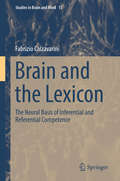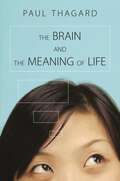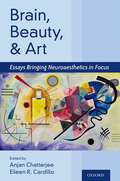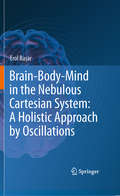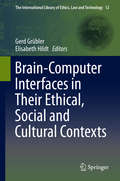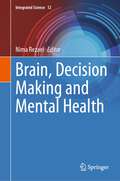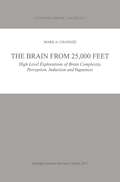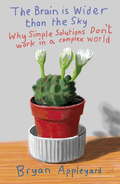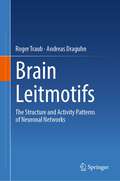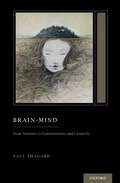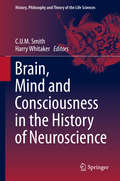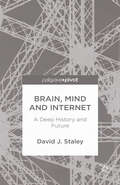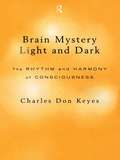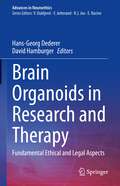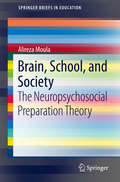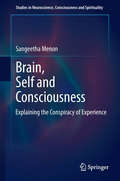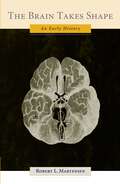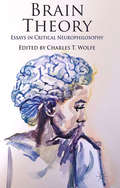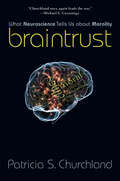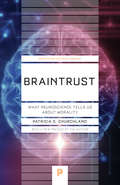- Table View
- List View
Brain and the Lexicon: The Neural Basis of Inferential and Referential Competence (Studies in Brain and Mind #15)
by Fabrizio CalzavariniThis monograph offers a novel, neurocognitive theory concerning words and language. It explores the distinction between inferential and referential semantic competence. The former accounts for the relationship of words among themselves, the latter for the relationship of words to the world. The author discusses this distinction at the level of the human brain on both theoretical and neuroscientific grounds. In addition, this investigation considers the relation between the inf/ref neurocognitive theory and other accounts of semantic cognition proposed in the field of neurosemantics, as well as some potential implications of the theory for clinical neuroscience and the philosophy of semantics. Overall, the book offers an important contribution to the debate about lexical semantic competence. It combines a strong philosophical and linguistic background with a comprehensive and critical analysis of neurosemantic literature. Topics discussed lie at the intersection of philosophical semantics, linguistics, neurolinguistics, cognitive science, artificial intelligence, cognitive neuroscience, and clinical psychology. Due to its interdisciplinary orientation, coverage is rich in introductory remarks and not overly technical, therefore it is accessible to non-experts as well.
The Brain and the Meaning of Life
by Paul ThagardWhy is life worth living? What makes actions right or wrong? What is reality and how do we know it? The Brain and the Meaning of Life draws on research in philosophy, psychology, and neuroscience to answer some of the most pressing questions about life's nature and value. Paul Thagard argues that evidence requires the abandonment of many traditional ideas about the soul, free will, and immortality, and shows how brain science matters for fundamental issues about reality, morality, and the meaning of life. The ongoing Brain Revolution reveals how love, work, and play provide good reasons for living. Defending the superiority of evidence-based reasoning over religious faith and philosophical thought experiments, Thagard argues that minds are brains and that reality is what science can discover. Brains come to know reality through a combination of perception and reasoning. Just as important, our brains evaluate aspects of reality through emotions that can produce both good and bad decisions. Our cognitive and emotional abilities allow us to understand reality, decide effectively, act morally, and pursue the vital needs of love, work, and play. Wisdom consists of knowing what matters, why it matters, and how to achieve it. The Brain and the Meaning of Life shows how brain science helps to answer questions about the nature of mind and reality, while alleviating anxiety about the difficulty of life in a vast universe. The book integrates decades of multidisciplinary research, but its clear explanations and humor make it accessible to the general reader.
The Brain and the Meaning of Life
by Paul ThagardWhy is life worth living? What makes actions right or wrong? What is reality and how do we know it? The Brain and the Meaning of Life draws on research in philosophy, psychology, and neuroscience to answer some of the most pressing questions about life's nature and value. Paul Thagard argues that evidence requires the abandonment of many traditional ideas about the soul, free will, and immortality, and shows how brain science matters for fundamental issues about reality, morality, and the meaning of life. The ongoing Brain Revolution reveals how love, work, and play provide good reasons for living. Defending the superiority of evidence-based reasoning over religious faith and philosophical thought experiments, Thagard argues that minds are brains and that reality is what science can discover. Brains come to know reality through a combination of perception and reasoning. Just as important, our brains evaluate aspects of reality through emotions that can produce both good and bad decisions. Our cognitive and emotional abilities allow us to understand reality, decide effectively, act morally, and pursue the vital needs of love, work, and play. Wisdom consists of knowing what matters, why it matters, and how to achieve it. The Brain and the Meaning of Life shows how brain science helps to answer questions about the nature of mind and reality, while alleviating anxiety about the difficulty of life in a vast universe. The book integrates decades of multidisciplinary research, but its clear explanations and humor make it accessible to the general reader.
Brain, Beauty, and Art: Essays Bringing Neuroaesthetics into Focus
by Anjan Chatterjee and Eileen R. CardilloAesthetics has long been the preserve of philosophy, art history, and the creative arts but, more recently, the fields of psychology and neuroscience have entered the discussion, and the field of neuroaesthetics has been born. In Brain, Beauty, and Art, leading scholars in this nascent field reflect on the promise of neuroaesthetics to enrich our understanding of this universal yet diverse facet of human experience. The volume consists of essays from foundational researchers whose empirical work launched the field. Each essay is anchored to an original, peer-reviewed paper from the short history of this new and burgeoning subdiscipline of cognitive neuroscience. Authors of each essay were asked three questions: 1) What motivated the original paper? 2) What were the main findings or theoretical claims made? and, 3) How do those findings or claims fit with the current state and anticipated near future of neuroaesthetics? Together, these essays establish the territory and current boundaries of neuroaesthetics and identify its most promising future directions. Topics include models of neuroaesthetics, and discussions of beauty, art, dance, music, literature, and architecture. Brain, Beauty, and Art will inform and stimulate anyone with an abiding interest in why it is that, across time and culture, we respond to beauty, engage with art, and are affected by music and architecture.
Brain, Beauty, and Art: Essays Bringing Neuroaesthetics into Focus
Aesthetics has long been the preserve of philosophy, art history, and the creative arts but, more recently, the fields of psychology and neuroscience have entered the discussion, and the field of neuroaesthetics has been born. In Brain, Beauty, and Art, leading scholars in this nascent field reflect on the promise of neuroaesthetics to enrich our understanding of this universal yet diverse facet of human experience. The volume consists of essays from foundational researchers whose empirical work launched the field. Each essay is anchored to an original, peer-reviewed paper from the short history of this new and burgeoning subdiscipline of cognitive neuroscience. Authors of each essay were asked three questions: 1) What motivated the original paper? 2) What were the main findings or theoretical claims made? and, 3) How do those findings or claims fit with the current state and anticipated near future of neuroaesthetics? Together, these essays establish the territory and current boundaries of neuroaesthetics and identify its most promising future directions. Topics include models of neuroaesthetics, and discussions of beauty, art, dance, music, literature, and architecture. Brain, Beauty, and Art will inform and stimulate anyone with an abiding interest in why it is that, across time and culture, we respond to beauty, engage with art, and are affected by music and architecture.
Brain-Body-Mind in the Nebulous Cartesian System: A Holistic Approach by Oscillations
by Erol BaşarBrain-Body-Mind in the Nebulous Cartesian System: A Holistic Approach by Oscillations is a research monograph, with didactical features, on the mechanisms of the mind, encompassing a wide spectrum of results and analyses. The book should appeal to scientists and graduate students in the fields of neuroscience, neurology, psychiatry, physiology, psychology, physics and philosophy. Its goals are the development of an empirical-analytical construct, denoted as “Reasonings to Approach the Mind”, and the comprehension of 20 principles for understanding the mind. This book amalgamates results from work on the brain, vegetative system, brains in the evolution of species, the maturing brain, dynamic memory, emotional processes, and cognitive impairment in neuro-psychiatric disorders (Alzheimer, Schizophrenia, Bipolar disorders). The findings are comparatively evaluated within the framework of brain oscillations and neurotransmitters. Further, a holistic approach links the brain to the cardiovascular system and overall myogenic coordination of the vegetative system. The results emphasize that EEG oscillations, ultraslow oscillations, and neurotransmitters are quasi-invariant building blocks in brain-body-mind function and also during the evolution of species: The temporal domain is where the importance of research on neural oscillators is indispensable. The core, holistic concept that emerges is that the brain, spinal cord, overall myogenic system, brain-body-oscillations, and neurotransmitters form a functional syncytium. Accordingly, the concept of “Syncytium Brain-Body-Mind” replaces the concept of “Mind”. P>
Brain-Computer-Interfaces in their ethical, social and cultural contexts (The International Library of Ethics, Law and Technology #12)
by Gerd Grübler Elisabeth HildtThis volume summarizes the ethical, social and cultural contexts of interfacing brains and computers. It is intended for the interdisciplinary community of BCI stakeholders. Insofar, engineers, neuroscientists, psychologists, physicians, care-givers and also users and their relatives are concerned. For about the last twenty years brain-computer-interfaces (BCIs) have been investigated with increasing intensity and have in principle shown their potential to be useful tools in diagnostics, rehabilitation and assistive technology. The central promise of BCI technology is enabling severely impaired people in mobility, grasping, communication, and entertainment. Successful applications are for instance communication devices enabling locked-in patients in staying in contact with their environment, or prostheses enabling paralysed people in reaching and grasping. In addition to this, it serves as an introduction to the whole field of BCI for any interested reader.
Brain, Decision Making and Mental Health (Integrated Science #12)
by Nima RezaeiBrain, Decision Making, and Mental Health acknowledges that thinking is not a constant phenomenon but varies considerably across cultures. Critical thinking is particularly important in bridging thinking divisions and its applicability across sciences, particularly medical sciences. We see critical thinking as educable and the arts as means to achieve this purpose. We address the multidimensional relationship between thinking and health and related mechanisms. Thinking mainly affects emotion regulation and executive function; in other words, both mental and physical health are related as a function of thoughts. Considering the thinking‐feeling‐emotion regulation/executive function pathway, it would be reasonable to propose thinking capacities‐based interventions to impact emotion regulation and executive function, such as mindfulness and psychotherapy. We review decision-making taking place in integrated and social contexts and discuss the decision-making styles-decision outcomes relation. Finally, artificial thinking and intelligence prepare us for decision-making outside the human mind.
The Brain from 25,000 Feet: High Level Explorations of Brain Complexity, Perception, Induction and Vagueness (Synthese Library #317)
by Mark A. ChangiziIn The Brain from 25,000 Feet, Mark A. Changizi defends a non-reductionist philosophy and applies it to a variety of problems in the brain sciences. Some of the key questions answered are as follows. Why do we see visual illusions, and why are illusions inevitable for any finite-speed vision machine? Why aren't brains universal learning machines, and what does the riddle of induction and its solution have to do with human learning and innateness? The author tackles such questions as why the brain is folded, and why animals have as many limbs as they do, explaining how these relate to principles of network optimality. He describes how most natural language words are vague and then goes on to explain the connection to the ultimate computational limits on machines. There is also a fascinating discussion of how animals accommodate greater behavioral complexity. This book is a must-read for researchers interested in taking a high-level, non-mechanistic approach to answering age-old fundamental questions in the brain sciences.
The Brain is Wider Than the Sky: Why Simple Solutions Don't Work in a Complex World
by Bryan AppleyardA brand-new book from the award-winning SUNDAY TIMES journalist Brian Appleyard.Simplicity has become a brand and a cult. People want simple lives and simple solutions. And now our technology wants us to be simpler, to be 'machine readable'. From telephone call trees that simplify us into a series of 'options' to social networks that reduce us to our purchases and preferences, we are deluged with propaganda urging us to abandon our irreducibly complex selves. At the same time, scientists tell us we are 'simply' the products of evolution, nothing more than our genes. Brain scanners have inspired neuroscientists to claim they are close to cracking the problem of the human mind. 'Human equivalent' computers are being designed that, we are told, will do our thinking for us. Humans are being simplified out of existence. It is time, says Bryan Appleyard, to resist, and to reclaim the full depth of human experience. We are, he argues, naturally complex creatures, we are only ever at home in complexity. Through art and literature we see ourselves in ways that machines never can. He makes an impassioned plea for the voices of art to be heard before those of the technocrats. Part memoir, part reportage, part cultural analysis, THE BRAIN IS WIDER THAN THE SKY is a dire warning about what we may become and a lyrical evocation of what humans can be. For the brain is indeed wider than the sky.
Brain Leitmotifs: The Structure and Activity Patterns of Neuronal Networks
by Roger Traub Andreas DraguhnThis book tackles the question of why the brain is so difficult to fully understand. In neuroscience, data are acquired and analyzed with astonishing techniques and accumulate rapidly. Nevertheless, try to explain how a person can think or why there is such a condition as schizophrenia, and it appears that we really know little. To approach these difficulties, the authors first present a number of case studies in which the operation of a neural circuit is worked out in some detail and, at the same time, the functional significance of the operation is also understood. These examples are complicated in their biologic specifics but are conceptually straightforward. The examples are hoped to provoke an appreciation for what neuroscience can accomplish. The authors then develop some thoughts on how these issues can be addressed----instead of considering cognition in general, taking instead a subset of cognition that does lend itself to formal description.
Brain-Mind: From Neurons to Consciousness and Creativity (Treatise on Mind and Society) (Oxford Series on Cognitive Models and Architectures)
by Paul ThagardHow do brains make minds? Paul Thagard presents a unified, brain-based theory of cognition and emotion with applications to the most complex kinds of thinking, right up to consciousness and creativity. Neural mechanisms are used to explain mental operations for analogy, action, intention, language, and the self. Brain-Mind develops a brilliant account of mental operations using promising new ideas from theoretical neuroscience. Single neurons cannot do much by themselves, but groups of neurons work together to accomplish powerful kinds of mental representation, including concepts, images, and rules. Minds enable people to perceive, imagine, solve problems, understand, learn, speak, reason, create, and be emotional and conscious. Competing explanations of how the mind works have identified it as soul, computer, brain, dynamical system, or social construction. This book explains minds in terms of interacting mechanisms operating at multiple levels, including the social, mental, neural, and molecular. Unification comes from systematic application of Chris Eliasmith's powerful Semantic Pointer Architecture, a highly original synthesis of neural network and symbolic ideas about how the mind works. This book belongs to a trio that includes Mind-Society: From Brains to Social Sciences and Professions and Natural Philosophy: From Social Brains to Knowledge, Reality, Morality, and Beauty. They can be read independently, but together they make up a Treatise on Mind and Society that provides a unified and comprehensive treatment of the cognitive sciences, social sciences, professions, and humanities.
Brain, Mind and Consciousness in the History of Neuroscience (History, Philosophy and Theory of the Life Sciences #6)
by C. U. M. Smith Harry WhitakerThis volume of essays examines the problem of mind, looking at how the problem has appeared to neuroscientists (in the widest sense) from classical antiquity through to contemporary times. Beginning with a look at ventricular neuropsychology in antiquity, this book goes on to look at Spinozan ideas on the links between mind and body, Thomas Willis and the foundation of Neurology, Hooke’s mechanical model of the mind and Joseph Priestley’s approach to the mind-body problem.The volume offers a chapter on the 19th century Ottoman perspective on western thinking. Further chapters trace the work of nineteenth century scholars including George Henry Lewes, Herbert Spencer and Emil du Bois-Reymond. The book covers significant work from the twentieth century, including an examination of Alfred North Whitehead and the history of consciousness, and particular attention is given to the development of quantum consciousness. Chapters on slavery and the self and the development of an understanding of Dualism bring this examination up to date on the latest 21st century work in the field.At the heart of this book is the matter of how we define the problem of consciousness itself: has there been any progress in our understanding of the working of mind and brain? This work at the interface between science and the humanities will appeal to experts from across many fields who wish to develop their understanding of the problem of consciousness, including scholars of Neuroscience, Behavioural Science and the History of Science.
Brain, Mind and Internet: A Deep History and Future
by D. StaleyThis essay places the emerging brain-Internet interface within a broad historical context: that the Internet represents merely the next stage in a very long history of human cognition whereby the brain couples with symbolic technologies. Understanding this 'deep history' provides a way to imagine the future of brain-Internet cognition.
BRAIN-MIND OSCMA C: From Neurons to Consciousness and Creativity (Treatise on Mind and Society) (Oxford Series on Cognitive Models and Architectures)
by Paul ThagardHow do brains make minds? Paul Thagard presents a unified, brain-based theory of cognition and emotion with applications to the most complex kinds of thinking, right up to consciousness and creativity. Neural mechanisms are used to explain mental operations for analogy, action, intention, language, and the self. Brain-Mind develops a brilliant account of mental operations using promising new ideas from theoretical neuroscience. Single neurons cannot do much by themselves, but groups of neurons work together to accomplish powerful kinds of mental representation, including concepts, images, and rules. Minds enable people to perceive, imagine, solve problems, understand, learn, speak, reason, create, and be emotional and conscious. Competing explanations of how the mind works have identified it as soul, computer, brain, dynamical system, or social construction. This book explains minds in terms of interacting mechanisms operating at multiple levels, including the social, mental, neural, and molecular. Unification comes from systematic application of Chris Eliasmith's powerful Semantic Pointer Architecture, a highly original synthesis of neural network and symbolic ideas about how the mind works. This book belongs to a trio that includes Mind-Society: From Brains to Social Sciences and Professions and Natural Philosophy: From Social Brains to Knowledge, Reality, Morality, and Beauty. They can be read independently, but together they make up a Treatise on Mind and Society that provides a unified and comprehensive treatment of the cognitive sciences, social sciences, professions, and humanities.
Brain Mystery Light and Dark: The Rhythm and Harmony of Consciousness
by Charles Don KeyesBrain Mystery Light and Dark examines scientific models of how the brain becomes conscious and argues that the spiritual dimension of life is compatible with the main scientific theories. Keyes shows us that the belief in the unity of mind and brain does not necessarily undermine aesthetic, religious, and ethical beliefs.
Brain Mystery Light and Dark: The Rhythm and Harmony of Consciousness
by Charles Don KeyesBrain Mystery Light and Dark examines scientific models of how the brain becomes conscious and argues that the spiritual dimension of life is compatible with the main scientific theories. Keyes shows us that the belief in the unity of mind and brain does not necessarily undermine aesthetic, religious, and ethical beliefs.
Brain Organoids in Research and Therapy: Fundamental Ethical and Legal Aspects (Advances in Neuroethics)
by Hans-Georg Dederer David HamburgerThis volume elucidates the pivotal ethical and legal issues arising from the use of brain organoids for research, therapeutic and enhancement purposes.The function of the human brain is still a mystery. Until recently, only post-mortem tissue was available for a structural examination of the brain. Consequently, the examination results could only reflect the state at the end of life. However, in order to better understand the development and function of the human brain, dynamic and functional investigations of different human brain cells are necessary. This is where brain organoids, artificially grown in vitro miniature brains, provide the opportunity for more flexible research scenarios.At the same time, however, the use of brain organoids in research and therapy raises the question of how these new entities are to be treated from an ethical and legal point of view. Against this background, this volume aims at clarifying the normative implications of the use of brain organoids in research and therapy. The ethical reflections on the status of brain organoids, informed consent, human-to-animal chimeras and neuro-enhancement are mirrored by corresponding legal analyses. The ethical and legal assessments are preceded by an introduction to the scientific and medical background of the brain organoid technology. A final chapter will be devoted to the issue of whether international harmonization of normative standards for brain organoid research and therapy is feasible and advisable.
Brain, School, and Society: The Neuropsychosocial Preparation Theory (SpringerBriefs in Education)
by Alireza MoulaThis book reports on a research program designed to construct the basics of a new type of literacy that teaches pupils social problem-solving at individual and collective levels. It is the first of a series of books about a chain of intervention research subprojects started in 2009 teaching pupils basic skills to make well-balanced decisions; to resolve conflicts in a nonviolent manner; and to develop good social relationships and responsibility, critical thinking, and other abilities which give children and young people the tools needed to pursue their options in life. According to the United Nations, there is no systematic program in schools that develops these capacities in pupils. This volume fills the gap by describing successful classroom interventions and by developing a framework for social problem-solving literacy as mandated by the United Nations Child Convention.
Brain, Self and Consciousness: Explaining the Conspiracy of Experience (Studies in Neuroscience, Consciousness and Spirituality #3)
by Sangeetha MenonThis book discusses consciousness from the perspectives of neuroscience, neuropsychiatry and philosophy. It develops a novel approach in consciousness studies by charting the pathways in which the brain challenges the self and the self challenges the brain. The author argues that the central issue in brain studies is to explain the unity, continuity, and adherence of experience, whether it is sensory or mental awareness, phenomenal- or self-consciousness. To address such a unity is to understand mutual challenges that the brain and the self pose for each other. The fascinating discussions that this book presents are: How do the brain and self create the conspiracy of experience where the physicality of the brain is lost in the subjectivity of the self?
Brain Theory: Essays in Critical Neurophilosophy
by Charles T. WolfePhilosophy has long puzzled over the relation between mind and brain. This volume presents some of the state-of-the-art reflections on philosophical efforts to 'make sense' of neuroscience, as regards issue including neuroaesthetics, brain science and the law, neurofeminism, embodiment, race, memory and pain.
Braintrust: What Neuroscience Tells Us about Morality
by Patricia S. ChurchlandWhat is morality? Where does it come from? And why do most of us heed its call most of the time? In Braintrust, neurophilosophy pioneer Patricia Churchland argues that morality originates in the biology of the brain. She describes the "neurobiological platform of bonding" that, modified by evolutionary pressures and cultural values, has led to human styles of moral behavior. The result is a provocative genealogy of morals that asks us to reevaluate the priority given to religion, absolute rules, and pure reason in accounting for the basis of morality. Moral values, Churchland argues, are rooted in a behavior common to all mammals--the caring for offspring. The evolved structure, processes, and chemistry of the brain incline humans to strive not only for self-preservation but for the well-being of allied selves--first offspring, then mates, kin, and so on, in wider and wider "caring" circles. Separation and exclusion cause pain, and the company of loved ones causes pleasure; responding to feelings of social pain and pleasure, brains adjust their circuitry to local customs. In this way, caring is apportioned, conscience molded, and moral intuitions instilled. A key part of the story is oxytocin, an ancient body-and-brain molecule that, by decreasing the stress response, allows humans to develop the trust in one another necessary for the development of close-knit ties, social institutions, and morality. A major new account of what really makes us moral, Braintrust challenges us to reconsider the origins of some of our most cherished values.
Braintrust: What Neuroscience Tells Us about Morality (PDF)
by Patricia S. ChurchlandWhat is morality? Where does it come from? And why do most of us heed its call most of the time? In Braintrust, neurophilosophy pioneer Patricia Churchland argues that morality originates in the biology of the brain. She describes the "neurobiological platform of bonding" that, modified by evolutionary pressures and cultural values, has led to human styles of moral behavior. The result is a provocative genealogy of morals that asks us to reevaluate the priority given to religion, absolute rules, and pure reason in accounting for the basis of morality. Moral values, Churchland argues, are rooted in a behavior common to all mammals--the caring for offspring. The evolved structure, processes, and chemistry of the brain incline humans to strive not only for self-preservation but for the well-being of allied selves--first offspring, then mates, kin, and so on, in wider and wider "caring" circles. Separation and exclusion cause pain, and the company of loved ones causes pleasure; responding to feelings of social pain and pleasure, brains adjust their circuitry to local customs. In this way, caring is apportioned, conscience molded, and moral intuitions instilled. A key part of the story is oxytocin, an ancient body-and-brain molecule that, by decreasing the stress response, allows humans to develop the trust in one another necessary for the development of close-knit ties, social institutions, and morality. A major new account of what really makes us moral, Braintrust challenges us to reconsider the origins of some of our most cherished values.
Braintrust: What Neuroscience Tells Us about Morality (Princeton Science Library (PDF))
by Patricia S. ChurchlandWhat is morality? Where does it come from? And why do most of us heed its call most of the time? In Braintrust, neurophilosophy pioneer Patricia Churchland argues that morality originates in the biology of the brain. She describes the "neurobiological platform of bonding" that, modified by evolutionary pressures and cultural values, has led to human styles of moral behavior. The result is a provocative genealogy of morals that asks us to reevaluate the priority given to religion, absolute rules, and pure reason in accounting for the basis of morality. Moral values, Churchland argues, are rooted in a behavior common to all mammals--the caring for offspring. The evolved structure, processes, and chemistry of the brain incline humans to strive not only for self-preservation but for the well-being of allied selves--first offspring, then mates, kin, and so on, in wider and wider "caring" circles. Separation and exclusion cause pain, and the company of loved ones causes pleasure; responding to feelings of social pain and pleasure, brains adjust their circuitry to local customs. In this way, caring is apportioned, conscience molded, and moral intuitions instilled. A key part of the story is oxytocin, an ancient body-and-brain molecule that, by decreasing the stress response, allows humans to develop the trust in one another necessary for the development of close-knit ties, social institutions, and morality. A major new account of what really makes us moral, Braintrust challenges us to reconsider the origins of some of our most cherished values.
